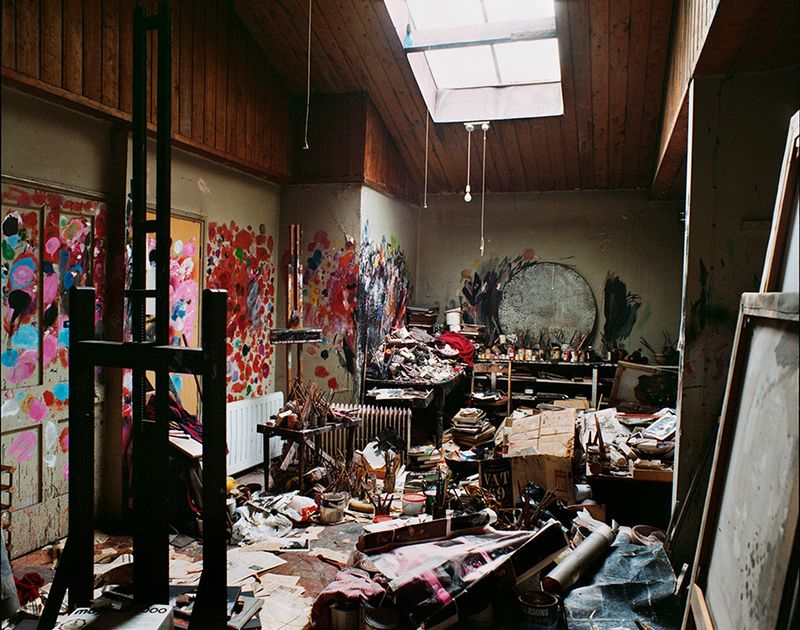THE JOURNAL

Recreation of Mr Eduardo Paolozzi’s studio at the Scottish National Gallery of Modern Art, Edinburgh. Photograph by Mr Antonio Reeve, courtesy of National Galleries of Scotland. © Trustees of the Paolozzi Foundation, Licensed by DACS 2017
Get inspired by the creative spaces of modern masters from Mr Henri Matisse to Mr Francis Bacon.
Lovely as it is to mooch around a gallery, hopefully having some intelligent thoughts about the works therein, there are few more immersive experiences, art-wise, than visiting the spaces in which these pieces were produced. Largely, of course, this isn’t possible. Most artists’ studios are not as carefully preserved for posterity as their priceless output. But there are a few exceptions, as well as interesting work-arounds. A case in point is the new exhibition at the Royal Academy in London, in which Mr Henri Matisse’s studio has been partially recreated in a display of the artworks and objects he liked to surround himself with while he worked. You can find out more about that below, but while we were at it, we thought we would suggest some other artists’ studios and homes (or recreations thereof) that are a must-visit for any serious art pilgrim.
Mr Henri Matisse

Mr Henri Matisse in his studio in Nice, 1953. Photograph by Ms Hélène Adant/Gamma Rapho/Camera Press. © Succession H. Matisse/ DACS 2017
The Matisse In The Studio exhibition at the Royal Academy (until 12 November) allows visitors a glimpse of Mr Henri Matisse’s working process by bringing together a cornucopia of unusual objects and artworks from the artist’s personal collection. Exhibited alongside the artworks that they have clearly inspired, the artefacts range from Andalusian glassware (which features in his 1925 painting “Safrano Roses At The Window”) to indigenous art from all over the globe, including Islamic screens, African masks and Thai Buddhist statues. This is not, strictly speaking, a recreation of Mr Matisse’s studio itself, but it nonetheless offers a rare opportunity to see how crucial details of his immediate working environment influenced – and continued to resurface in – his work. Also, it’s Matisse. We’ll take what we can get, eh?
Ms Georgia O’Keeffe

Ms Georgia O’Keeffe’s Abiquiu House, Sitting Room, 2007. Photograph by Mr Herbert Lotz, courtesy of Georgia O’Keeffe Museum. © Georgia O'Keeffe Museum
Ms Georgia O’Keeffe not only worked in her studio in Abiquiú, New Mexico, but lived there. She spent many years lovingly restoring the place, a 5,000sq ft Spanish colonial ranch, after a 15-year campaign to buy it in 1945 (it was not for sale when she originally saw it in 1930). As you might expect, it turned out rather well – a blissful artistic sanctuary with views over the Chama river valley, simply decorated with just a few well-chosen artworks. Visitors to this space, which is as it was while Ms O’Keeffe lived there, can also visit nearby Ghost Ranch, a desert retreat that inspired many of the scenes in her sensuous landscape paintings.
Mr Eduardo Paolozzi

Recreation of Mr Eduardo Paolozzi’s studio at the Scottish National Gallery of Modern Art, Edinburgh. Photograph by Mr Antonio Reeve, courtesy of National Galleries of Scotland. © Trustees of the Paolozzi Foundation, Licensed by DACS 2017
Much of proto-pop (some might say brutalist) artist Mr Eduardo Paolozzi’s work was clearly the result of his magpie-like habits, from his early collage work to the highly textured sculptures he created from assemblages of industrial bric-a-brac. Walking into his permanently preserved studio at the Scottish National Gallery of Modern Art in Edinburgh is like taking a step into his insatiably curious mind, chaotically stacked as it is with maquettes, moulds, toys and reference books. Tellingly, it also houses a bunk bed – for the nights when Mr Paolozzi could not drag himself away.
Mr Donald Judd

Mr Donald Judd’s residence and studio at 2nd Floor, 101 Spring Street, New York. Photograph by Mr Charlie Rubin. © Judd Foundation
Central to minimalist sculptor Mr Donald Judd’s artistic philosophy was the concept of permanent installation, that is, creating lasting, sympathetic spaces in which art could be installed and fully appreciated. His first triumph in this regard was his own home at 101 Spring Street, New York, a serene living space in which Mr Judd’s own, stripped-back furniture designs sit beside artworks from his friends Messrs John Chamberlain and Dan Flavin. Since his death in 1994, the space has been preserved as Mr Judd installed it by the Judd Foundation and is open for tours (though, as it’s routinely sold out, it’s advisable to book well in advance).
Mr Francis Bacon

Francis Bacon Studio at 7 Reece Mews. Photograph by Mr Perry Ogden, courtesy of Dublin City Gallery The Hugh Lane. © The Estate of Francis Bacon. All rights reserved. DACS 2017
The Francis Bacon Studio at the Hugh Lane Gallery in Dublin is a rather miraculous achievement. It was transported here, piece by piece, from London in 1998, an effort that required the skills of a team of conservators and archaeologists. More than 7,000 objects were tagged and catalogued in the process, while the original walls were removed and relocated in their entirety. The result is a space that, with its piles of torn books and newspapers, slashed canvases and paint-spattered surfaces, still feels viscerally alive.